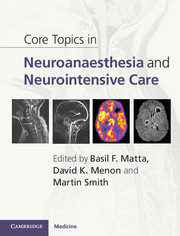19 results
13 - Anaesthesia for intracranial vascular surgery and carotid disease
- from Section 3 - Neuroanaesthesia
-
-
- Book:
- Core Topics in Neuroanaesthesia and Neurointensive Care
- Published online:
- 05 December 2011
- Print publication:
- 13 October 2011, pp 178-204
-
- Chapter
- Export citation
Plates - PDF Only
-
- Book:
- Core Topics in Neuroanaesthesia and Neurointensive Care
- Published online:
- 05 December 2011
- Print publication:
- 13 October 2011, pp -
-
- Chapter
- Export citation
Contents
-
- Book:
- Core Topics in Neuroanaesthesia and Neurointensive Care
- Published online:
- 05 December 2011
- Print publication:
- 13 October 2011, pp iv-vi
-
- Chapter
- Export citation
Copyright page
-
- Book:
- Core Topics in Neuroanaesthesia and Neurointensive Care
- Published online:
- 05 December 2011
- Print publication:
- 13 October 2011, pp iv-iii
-
- Chapter
- Export citation
5 - Bedside measurements of cerebral blood flow
- from Section 2 - Monitoring and imaging
-
-
- Book:
- Core Topics in Neuroanaesthesia and Neurointensive Care
- Published online:
- 05 December 2011
- Print publication:
- 13 October 2011, pp 63-71
-
- Chapter
- Export citation
Section 4 - Neurointensive care
-
- Book:
- Core Topics in Neuroanaesthesia and Neurointensive Care
- Published online:
- 05 December 2011
- Print publication:
- 13 October 2011, pp 271-497
-
- Chapter
- Export citation
Preface
-
-
- Book:
- Core Topics in Neuroanaesthesia and Neurointensive Care
- Published online:
- 05 December 2011
- Print publication:
- 13 October 2011, pp xi-xii
-
- Chapter
- Export citation
Section 2 - Monitoring and imaging
-
- Book:
- Core Topics in Neuroanaesthesia and Neurointensive Care
- Published online:
- 05 December 2011
- Print publication:
- 13 October 2011, pp 45-146
-
- Chapter
- Export citation
Section 3 - Neuroanaesthesia
-
- Book:
- Core Topics in Neuroanaesthesia and Neurointensive Care
- Published online:
- 05 December 2011
- Print publication:
- 13 October 2011, pp 147-270
-
- Chapter
- Export citation
22 - Management of aneurysmal subarachnoid haemorrhage in the neurointensive care unit
- from Section 4 - Neurointensive care
-
-
- Book:
- Core Topics in Neuroanaesthesia and Neurointensive Care
- Published online:
- 05 December 2011
- Print publication:
- 13 October 2011, pp 341-358
-
- Chapter
- Export citation
Core Topics in Neuroanaesthesia and Neurointensive Care - Title page
-
-
- Book:
- Core Topics in Neuroanaesthesia and Neurointensive Care
- Published online:
- 05 December 2011
- Print publication:
- 13 October 2011, pp iii-iii
-
- Chapter
- Export citation
Acknowledgements
-
- Book:
- Core Topics in Neuroanaesthesia and Neurointensive Care
- Published online:
- 05 December 2011
- Print publication:
- 13 October 2011, pp xiii-xiv
-
- Chapter
- Export citation
Core Topics in Neuroanaesthesia and Neurointensive Care - Half title page
-
- Book:
- Core Topics in Neuroanaesthesia and Neurointensive Care
- Published online:
- 05 December 2011
- Print publication:
- 13 October 2011, pp i-ii
-
- Chapter
- Export citation

Core Topics in Neuroanaesthesia and Neurointensive Care
-
- Published online:
- 05 December 2011
- Print publication:
- 13 October 2011
Section 1 - Applied clinical physiology and pharmacology
-
- Book:
- Core Topics in Neuroanaesthesia and Neurointensive Care
- Published online:
- 05 December 2011
- Print publication:
- 13 October 2011, pp 1-44
-
- Chapter
- Export citation
Contributors
-
-
- Book:
- Core Topics in Neuroanaesthesia and Neurointensive Care
- Published online:
- 05 December 2011
- Print publication:
- 13 October 2011, pp vii-x
-
- Chapter
- Export citation
Index
-
- Book:
- Core Topics in Neuroanaesthesia and Neurointensive Care
- Published online:
- 05 December 2011
- Print publication:
- 13 October 2011, pp 498-519
-
- Chapter
- Export citation
29 - Intensive care of cardiac arrest survivors
- from Section 4 - Neurointensive care
-
-
- Book:
- Core Topics in Neuroanaesthesia and Neurointensive Care
- Published online:
- 05 December 2011
- Print publication:
- 13 October 2011, pp 445-456
-
- Chapter
- Export citation
40 - An overview of S-100β as a clinically useful biomarker of brain tissue damage
-
-
- Book:
- Biomarkers of Disease
- Published online:
- 20 August 2009
- Print publication:
- 06 June 2002, pp 406-412
-
- Chapter
- Export citation

